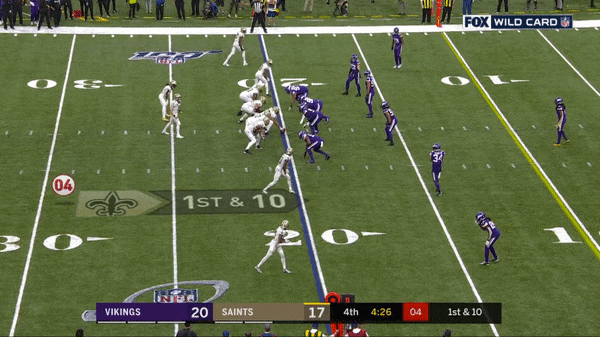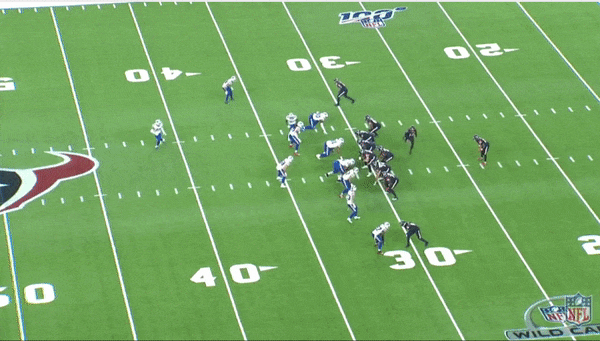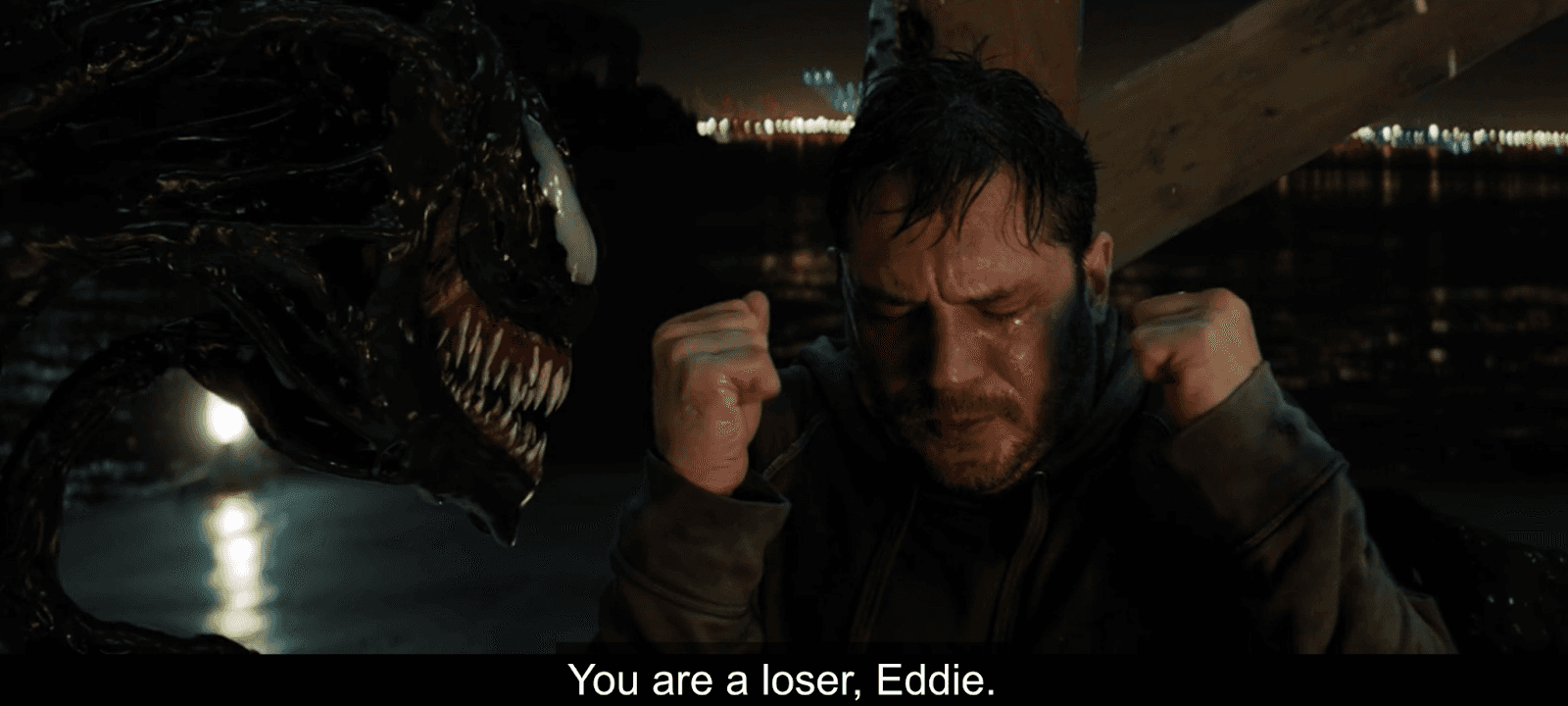It’s often said that college football and the NFL are two completely different sports. But many concepts that long thrived on campus have recently taken hold in the league. We’re spending today examining the intersection of both levels of the game, and how certain schemes and tendencies are shaping the future of the modern pro offense.
The RPO defined the NFL last season. Those three letters dominated football conversations through Super Bowl LII and beyond, in large part because of the run-pass option’s prevalence in the Eagles offense. From broadcast booths to coaching interviews, RPO became the buzzworthy phrase around professional football.
We’ve seen this sort of craze before. A decade ago, the Dolphins and their wildcat formation took the league by storm. Four years later, the zone read was the preferred offensive concept of half the teams in the NFC playoffs. Trends come and go in the NFL; what allows an approach to move beyond schematic fad du jour and become a fixture of the league is the adaptability of that concept as defenses adjust.
To find RPO adaptations, NFL coaches would be well served to mine the territory they did when implementing the concept: college football. The league’s most common iteration of the run-pass option remains in its infant stages compared with how RPOs are used at the college level. The idea behind RPOs is simple: A quarterback goes into a play with the option to hand off or pass, and makes that determination after reading an opposing defender. More often than not last season, RPO-heavy NFL teams such as the Chiefs and Eagles read a defense’s backside linebacker and used quick, man-beating routes as a way to exploit him.
How many times a game do you want to put a quarterback in that kind of stress? It’s similar to how many times you ask the quarterback to run the ball.Princeton head coach Bob Surace
But that’s only the tip of the RPO iceberg. The strategy can exploit much more than just the tendencies of backside linebackers. In college, the number of defenders who can be read on a given RPO is extensive, offering offenses a wide array of options to attack. “People will say this is clinic talk or it looks good on the board, but within our scheme, we can read any of the four down guys,” says Mississippi State head coach Joe Moorhead, a premier college football innovator who worked as Saquon Barkley’s offensive coordinator at Penn State for the past two seasons. “We have calls where we can read anyone on the second level outside of the field corner.”
Pro teams’ catalog of RPO concepts can be limited by the NFL’s values, rules, and schematic structure. Central to that predicament is the league’s reluctance to run quarterbacks. “One of my answers [to certain defensive adjustments] is I’m going to run the QB,” Bryant University head coach James Perry says. “I know that [no NFL teams] want to do that.” This is why some players believe the RPO will phase out of the NFL in short order. Ravens safety Eric Weddle recently told reporters that he thinks the RPO will disappear from the league in five years.
The challenge for NFL coaches is deciphering which elements of the RPO can fit within their team’s structure. Their success could be the difference between the RPO going down as a fad and as the way of the future. “As a coach, you know the gist of what they’re trying to do and say, ‘That doesn’t fit us,’” Vikings offensive coordinator John DeFilippo says. “You know real fast what fits your team and what doesn’t.”
To understand where the NFL’s variant of the RPO will go from here, it’s necessary to first identify the restrictions brought on by the differences between the pro and college games. This is the football version of the adage that certain animals grow to the size of their tank. The caution with which NFL franchises handle their quarterbacks limits the library of RPO tactics that many teams are willing to use.
RPOs, at their core, are highly advanced extensions of old-school option principles. On zone reads and triple-option plays, QBs read first-level defenders such as defensive tackles and defensive ends and make decisions based on how those players react. From there, offenses key in on second-level defenders like linebackers and slot cornerbacks in an attempt to manipulate areas in the middle of the field. That’s the current extent of NFL RPOs. The college game takes the tactic a step further. As defenses began to adapt, offensive coaches started implementing third-level reads that are predicated on how a safety responds to specific actions. Those are the plays that might be one bridge too far for the NFL.
Vertical routes paired with third-level reads often put a quarterback in peril, because of how long these plays take to develop. If a QB doesn’t get rid of the ball quickly enough, he could be in for a beating. “It depends on how much freedom you want to give the quarterback to get pummeled at times,” Princeton head coach Bob Surace says. “You can read safeties on that, but man, you’ve got to hold the ball on some of those things.”
Surace recalls how third-level RPOs were a staple of Cal’s offense during Jared Goff’s tenure—and how it contributed to Goff being sacked a whopping 81 times from 2013 to 2015. Cal allowed 33 sacks during Goff’s freshman year alone, tied for 99th among the 125 programs that were then in the FBS. “How many times a game do you want to put a quarterback in that kind of stress?” Surace asks. “It’s similar to how many times you ask the quarterback to run the ball.”
Chip Kelly told me that he didn’t even run RPOs in San Francisco because [defenses] played so much man coverage.Mike Kuchar, X&O Labs cofounder
This leads to another big reason RPOs might never become as central to NFL offenses as they are to their college counterparts. Since many of the earliest RPO designs incorporated bubble screens aimed at defeating zone coverage, defenses began to deploy man-coverage looks more frequently. In man-to-man coverage with a single high safety, defenses are left vulnerable to quarterbacks keeping the ball and sprinting around the edge. This can produce huge chunks of yardage, but also leaves quarterbacks at increased risk of getting hit. “It doesn’t turn into an RPO,” Moorhead says of these wrinkles. “It turns into a run play where you’re reading a defender at the first or second level, and your quarterback just runs it.”
With these quarterback runs off the table, NFL offenses have been forced to find different ways to counteract man coverage within RPO designs. When Chip Kelly first brought RPOs to NFL prominence with the Eagles in 2013, Philadelphia’s offense consistently coupled zone runs with bubble screens to manipulate zone defenses. Yet when defensive coordinators countered by deploying more man coverage, Kelly’s designs fell flat. “Chip Kelly told me that he didn’t even run RPOs in San Francisco because [defenses] played so much man coverage,” says Mike Kuchar, a cofounder of X&O Labs, a research company for football coaches.
During the second wave of RPO offense in Philly, though, head coach Doug Pederson and his staff experimented with ways to marry man-beating route combinations with an approach aimed at defeating zone coverage. Their hybrid solution was a smashing success that provides insight into how future NFL teams can fit RPO concepts into the constraints of the professional game.
The back-and-forth between NFL offensive and defensive coaches is a full-contact exercise in Newton’s third law of motion: For every action, there is an equal and opposite reaction—one that can come in the form of criss-crossing receivers, surprise wrinkles, and ever-changing layers of deception. Last season, when defenses began to use a steadier diet of man coverage to combat the Eagles’ RPOs, Pederson and his staff understood they’d need more route combinations specifically designed to exploit one-on-one matchups.

Those combinations came in a few different variations. The Eagles started folding more rub and pick designs into their RPO menu, especially during the playoffs. In the second quarter of the NFC championship game against the Vikings, for example, Philly faced a third-and-1 from the Minnesota 17-yard line. Pederson’s team lined up in a two-by-two set with a pair of receivers stacked wide to the left and tight end Zach Ertz and receiver Mack Hollins positioned to the right. At the snap, Hollins darted inside to put a de facto screen on safety Harrison Smith, while Ertz released outside. Quarterback Nick Foles floated a throw to Ertz for a 6-yard gain; on the next play, LeGarrette Blount barrelled into the end zone for a touchdown.
“[That was] a special play specifically designed for third-and-short situations,” says DeFilippo, who served as the Eagles quarterbacks coach last season. “It works particularly well against teams that rotate their safeties hard [like the Vikings].” Devising concepts to beat man coverage is a requirement for dropback passing games in the NFL, so merging those route combinations with RPO principles doesn’t require a huge leap.
Ertz’s crucial conversion included a run action by Jay Ajayi, but Foles knew where the ball was going before it was even snapped. Conventional wisdom surrounding RPOs is that the quarterback makes a read after the snap and reaches a decision based on a defender’s movements. But DeFilippo says the ratio is tipped the other way. “Based on box numbers [or whether the] corner is playing off, those are pre-snap decisions before you get the ball in your hands,’” he says. DeFilippo estimates about 70 percent of the quarterback’s choices on an RPO are made before a play begins.

Some of those pre-snap decisions are based on a defender’s leverage when he lines up. While most RPO play designs rely on in-breaking routes that attack space at the second level, the Eagles incorporated routes toward the sideline that made defenses pay for playing lax man coverage in order to safeguard against getting roasted one-on-one. In Perry’s mind, this explains how NFL teams can find so much success with man-beating routes in RPOs. The respect defenses must pay to the league’s most dynamic receivers make those units susceptible to quick routes like slants. “In the NFL, if you tell the guy covering that slot to play him head up, he’ll tell you to go take a dump in a hat,” Perry says. “Because they’re then just going to get beat deep. If you play Odell Beckham head up, he’s going to run a slot fade on you, and you literally have no shot at covering him.”
Moorhead welcomes blanket press coverage. When opposing defenses elected to crowd his receivers last season at Penn State, he’d simply instruct his quarterback, via hand signals from the sideline, to check from the called RPO into a dropback pass that sent at least one target on a vertical route. With tight end Mike Gesicki often working against an outclassed defender in the slot, this was a matchup Moorhead gladly took. “If you’re willing to come down and play press across the board, I like to believe I have the pen in my hand last,” Moorhead says. “I’m just going to get out of that play and go to something else.”
The autonomy NFL coaches give to many quarterbacks affords them the same freedom to check out of plays based on certain defensive looks. When the Eagles saw a light box last season, they’d use hand signals to eliminate the pass elements of an RPO call entirely. By turning those snaps into more straightforward running plays, Philadelphia was able to return to the same formation later on. If defenses chose to stack the box that time around, the Eagles could break out passing elements they hadn’t yet unveiled.
DeFilippo says that one common defensive tactic the Eagles saw down the stretch involved teams blitzing the linebacker that Foles was reading on the RPO. That method has also become popular at the NCAA level. While Perry says this approach does present problems, he notes that it’s also a sign that the RPO is working. His solution in these cases is to hand the ball off and hope that the linebacker abandoning his assignment in the ground game allows backs to gash the defense on zone runs. “If you’re in the defense’s head enough that on a run play, they’re trying to take away the slant, you’ve already won,” Perry says. “If the line is blocking a run and the defense is focused on how to stop the slant, I’d tell my quarterback to feel free to give the ball. The run-pass option has already achieved its goal.”
NFL teams’ slight RPO tweaks to account for defensive adjustments have already started to pop up around the league. But there are more radical extensions of the run-pass option that have thus far been limited to just high school and college football.

Princeton’s offense has consistently been at the forefront of college innovation, including introducing one revolutionary concept. Over the past several seasons, the Tigers’ backup quarterbacks have often been among the best athletes on the roster. In order to get those players on the field more often, Surace and his staff began lining them up as running backs in shotgun sets and using them in the run half of RPOs. If the backup QB kept the ball on a given snap, a second read would come into play. “He’s reading a defender at the second level, a strong safety in Cover 3, and we’d run a flood route behind it,” Surace says. “He can either run it if [defenses] decide to take away the deeper route, on the flood, or throw it if that guy starts attacking the line of scrimmage.”
Most years, that type of revolutionary play call would be out of the question for NFL offenses. This season, though, Surace believes the Ravens have the personnel to make it work. “There’s no law against it,” Surace says. “You want to get Lamar Jackson on the field.”
In the NFL, if you tell the guy covering that slot to play him head up, he’ll tell you to go take a dump in a hat. Because they’re then just going to get beat deep.James Perry, Bryant University head coach
Surace knows how improbable this might sound. Two-quarterback sets, multiple reads … it feels better suited for backyard football than the AFC North. But the coach makes clear that his staff hasn’t conjured up a brand-new version of football. It’s just taken familiar but unrelated concepts and melded them together. “We’re not this group of geniuses,” Surace says. “We want to be creative, but more often than not, we run mid-zone behind [the route concepts]. It’s nothing new for the O-line, the tight end, the guys blocking. The route concepts are nothing new for the receivers. It’s very standard stuff. But it puts a lot of stress on the defense.”
This rationale could usher in what Kuchar believes will be the next phase of RPO offense in the NFL. Some of the more innovative offenses at lower levels of the sport have begun to introduce pass-screen options into their playbooks. Rather than calling a screen in the huddle and pairing it with secondary routes, the PSO features a quarterback making a post-snap read that allows him to choose between a quick playside pass and a backside delayed screen to a running back. Usually, the quarterback elects to throw the screen. On the rare occasion that a frontside receiver wins at the line of scrimmage, though, PSOs can produce easy completions and nice gains.
Whether NFL coaches are ready to embrace the full extent of RPO possibility remains to be seen. It’s possible that the Ravens will consider two-quarterback concepts as a way to get Jackson on the field. The Saints could turn to PSOs this fall, sending Michael Thomas inside and releasing Alvin Kamara on a delayed screen the other way. At the very least, it seems that the buzz around RPOs isn’t going away—regardless of how quickly the concept evolves in 2018. “We’ll have our own spin to it,” DeFilippo says of the role of the RPO in the Vikings offense. “I’ll leave it at that.”
